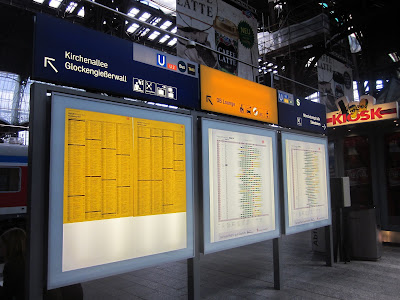In the beginning, though, Bahn Card or not, railway travel caused me excessive anxiety.
I’d been in Germany for a week—Berlin to be exact—when my small student troop was bussed to Bavaria on a whirlwind tour. Wanting to visit friends in Hesse on the way back north, I booked a Friday afternoon train ticket from Nürnberg to Kassel-Wilhelmshöhe.
At the station, once I had left my group and headed into the narrow, grey corridor to the platforms, my heart started racing. Listening to the sleek Intercity-Express (ICE) trains screech into the station, snaking their white bodies into the narrow track gaps, I contemplated their lengthy expanse, wondering how I’d ever find my assigned wagon and seat.
On my platform 15 minutes before departure, I almost stopped breathing as a train rushed in—10 minutes too early. I frantically jogged the length of the metal cars, searching for my number. Then I noticed the train’s sign: it was not north-bound. Backing away with my suitcase from my almost trip to Zürich, I realized that the trains were more exactly punctual than I’d imagined. In fact, when I looked up again, having worked through my harried thoughts, the train had already screamed back out of the station.
Seasoned tourists may be laughing by now—surely I knew how to navigate the train system. Sadly, during my pioneer venture with Deutsche Bahn, I neither knew about the billboard-wide train diagram posters, nor could I understand the mumbled announcements alerting travellers to platform changes and train delays.
So concerned was I about missing my train, I nearly doubled over in panic. Instead of completing the internship I was scheduled to start at a local Berlin newspaper, I was about to become one of its headlines.
Nonetheless, I managed to make it onto my train, not to the seat I’d reserved or even the correct wagon, but I found myself exhaling rapidly in a free window seat, watching the landscape sweeping past and concentrating on slowing my heart rate. Popping in my earbuds, I turned on my iPod and attempted to enjoy the ride.
About 20 minutes later, the conductor ambled through the wagon, checking passengers’ tickets. Handing him the smaller of my two pieces of shiny machine-printed paper, I didn’t bother to take out my headphones, figuring he’d stamp my ticket and move on. However, he angrily returned my paper, sans stamp, and said something that I didn’t quite catch over my music.
“What?”
“This isn’t a ticket.”
“What!?”
Panic attack number two. Opening my wallet and shuffling through my overflowing collection of souvenir tickets and receipts, I looked for my ticket. Finally, I handed him the other piece of shiny paper—the longer match to what I’d given him before—only this time the actual ticket, not my reservation. The conductor punched my ticket, glaring, and lectured me on talking over music before he moved on to the next row.
Cheeks flushed in embarrassment, I huddled back into the corner of my seat, already dreading the Sunday leg of my train journey from Kassel back to Berlin. How was I supposed to know the difference between the reservation and the ticket? This was my first European railway venture, and already train travel was confusing and anxiety-inducing!
Three years of trains turned this novice into a pro, though, and other travellers can also easily avoid the pitfalls I encountered on my first trip.
Finding the assigned wagon and seat, per reservation, doesn’t have to involve a timed-to-the-second sprint along the train (an athletic feat made even more interesting when toting one or more overstuffed--and in my case, broken--suitcases). Large signs located in most main stations detail each train’s layout, according to wagon number and platform section. A leisurely walk to the appropriate section will suffice.
If, however, penny pinching is more important than paying the small fee for an allocated seat, considering the time of day and date of travel might be wise.
In December, for example, I substituted my travel bag as a portable chair—crammed between purses, ski bags, Christmas gifts and the other 20 people lodged in the entry area of the ICE train. Railway demand was so hefty that day, Deutsche Bahn eventually kicked seatless passengers off the train, requiring us to wait for replacement transportation due sometime after the other train resumed its journey.
For solo forays, I often prefer to afford flexibility rather than a reservation, but I’ve also landed seats on the stairs leading up from the closed train doors, and on the floor in front of the bathroom—not the best way to enjoy the pricey ticket or the continuously-changing panorama outside the speeding train.
Identifying travel documents (i.e. ticket, reservation, itinerary) at the station and keeping them handy the first few minutes of the trip will also prevent skirmishes with train personnel. When in doubt, hand over everything to the ticket-stamper—he or she knows exactly which paper is needed.
Even though I'll probably spend this July mostly at home in Wernigerode, train travel will undoubtably continue to provide convenient connections for future excursions in the next year, especially now that I've eliminated much of the stress of climbing aboard.

No comments:
Post a Comment